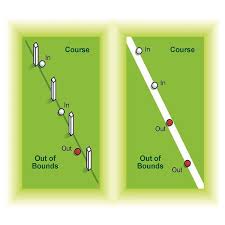Procedure For A Ball Out Of Bounds
A Ball Out Of Bounds
There seems to be a lot of confusion about when a ball is in-bounds or out-of-bounds. Furthermore, most golfers are unsure how to proceed if and when a ball is OB. Here is a simple clarification.
A ball at rest is out of bounds only when all of it is outside the boundary edge of the course. Usually the boundary edge is marked with white stakes. Sometimes OB is defined by a white line. Sometimes a fence may be considered OB. Regardless, a ball is in bounds when any part of the ball lies on or touches the ground that defines the boundary edge. Out of bounds also extends both up above the ground and down below the ground. So be careful if your ball is up in a tree. You need to know the exact boundry edge in a vertical sense. A player may stand out of bounds to play a ball on the course. Remember, you may not remove stakes or a fence to play your shot when they mark OB!
A player may stand out of bounds to play a ball on the course. Remember, you may not remove stakes or a fence to play your shot when they mark OB!
Procedure For OB
If your ball is OB, you must play your next shot as close to the spot at which the original ball was played. You will incur a one stroke penalty. So you actually lose all the distance that the shot produced. It is called a “stroke and distance”penalty. Few golfers know this rule. To speed up play for recreational golf, there is an exception. The new “stroke and distance” local rule allows players the option of dropping in the fairway to play their next shot. Players must first find where their ball went out of bounds. Then drop a new ball equidistant in the fairway not closer to the hole. The next shot would still be your fourth.
It is important to know the rules. Let The Ultimate Golf School help you learn the rules, it could actually save you some strokes in the future.

